#Doryx
Explore tagged Tumblr posts
Text

Valentine '25 💛💚
#valentines day#furry#furry art#digital art#anthro#my ocs#Skye Whitewings#art for others#my art#okamiwhitewings#whitewingsart#Doryx#wolf#deer#fallow deer#2025
12 notes
·
View notes
Text
Doxycycline Hyclate


Common Brand Names: Vibramycin, Doryx
Generic Available
Common Dosage Forms:
Tablets: 20 mg, 100 mg
Capsules:50 mg, 100 mg
Tablets, delayed-release: 75 mg, 100 mg, 150 mg
Syrup: 50 mg/5 mL (as calcium salt)
Powder for Oral Suspension: 25 mg as monohydrate per 5 mL after reconstitution, raspberry flavor
Powder for injection: 100 mg, 200 mg per vial
*Doxycycline monohydrate capsules are available as Monodox
FDA Indications/Dosages:
Infections due to susceptible strains of Gram-negative/Gram-positive bacilli and cocci, spirochetes, Mycoplasma pneumoniae, actinomycetes, and rickettsiae: 100 mg every 12 hours on the first day followed by 100-200 mg per day in one or two divided doses.
Primary and secondary syphilis: 300 mg per day in divided doses for at least 10 days.
Uncomplicated gonorrhea: 100 mg twice a day for 7 days, or 300 mg stat followed in one hour by a second 300 mg dose.
Uncomplicated urethral, endocervical, or rectal infections due to Chlamydia trachomatis: 100 mg twice a day for at least 7 days.
Prophylaxis of malaria due to Plasmodium falciparum in short-term travelers to areas with strains resistant to other therapy: 100 mg daily beginning 2 days prior to departure and continuing for 4 days after return.
Children (over 8 years old): 4.4 mg/kg initially in two divided doses followed by 2.2-4.4 mg/kg per day.
Monitor: CBC
Pharmacology/Pharmacokinetics: Doxycycline is a tetracycline antibiotic which prevents bacterial protein synthesis by competitively binding to the 30 S ribosomal subunit. Bacteriostatic at normal dosage ranges. Peak plasma levels are reached in 2 hours after an oral dose with a half-life of 18-22 hours. Excretion of unchanged drug occurs in the bile and urine.
Drug Interactions: May impair the action of bactericidal antibiotics. May impair the systemic absorption of oral contraceptives. May increase the bioavailability of digoxin. Absorption impaired by aluminum, zinc, and iron salts, and urinary alkalizers. Use with METHOXYFLURANE may produce nephrotoxicity.
Contraindications/Precautions: Contraindicated in patients hypersensitive to any tetracycline. Use with precaution in children under 8 years of age (during tooth development) and in patients with renal function. Cases of Clostridium difficile associated diarrhea have occurred during treatment with tetracyclines. Persistent or severe diarrhea should be reported to a physician. Use in lactation only if benefits clearly outweigh risks. Pregnancy Category D.
Adverse Effects: Dizziness, vertigo, nausea, vomiting, diarrhea, increased sensitivity to sunlight, discoloration of forming teeth, sore or darkened tongue, cramps, and burning stomach.
Patient Consultation:
Preferably taken on an empty stomach--one hour before or two hours after meals--with a full glass (240 mL) of water.
May be taken with food or milk if GI upset occurs.
Take at even intervals, preferably around the clock.
Complete full course of therapy unless otherwise directed.
Shake suspension well before using.
Avoid prolonged exposure to sunlight.
Store in a cool, dry place away from sunlight and children.
If a dose is missed, take it as soon as possible and return to dosing schedule.
Contact a physician if the above side effects are severe or persistent.
#sigler drug cards#36th edition#doxycycline hyclate#vibramycin#doryx#tetracycline antibiotic#drug facts
0 notes
Text
Typhus
Typhus is a disease caused by infection with one or more rickettsial bacteria. Fleas, mites (chiggers), lice, or ticks transmit it when they bite you. Fleas, mites, lice, and ticks are types of invertebrate animals known as arthropods. When arthropods carrying around rickettsial bacteria bite someone, they transmit the bacteria that causes typhus. Scratching the bite further opens the skin and allows the bacteria greater access to the bloodstream. Once in the bloodstream, the bacteria continue to reproduce and grow.
There are three different types of typhus:
epidemic (louse-borne) typhus is a rare variety spread by infected body lice. It’s unlikely to happen outside of extremely crowded living conditions. One type of epidemic typhus can be spread by infected flying squirrels, again, very rare.
endemic (murine) typhus is passed by fleas to people if the fleas bite infected animals, mainly rats. Most U.S. cases have been reported in California, Hawaii, and Texas
scrub typhus is spread by infected chiggers, or mites, mainly found in rural parts of Southeast Asia, China, Japan, India, and northern Australia.
All three kinds of typhus can cause serious illness, so get immediate treatment if you think you might have been exposed to it.
Causes:
Typhus is not transmitted from person to person like a cold or the flu. There are three different types of typhus, and each type is caused by a different type of bacterium and transmitted by a different type of arthropod. The type of typhus you are infected with depends on what bit you. Arthropods are typically carriers of a typhus strain unique to their species. Insects and other parasites spread murine and epidemic typhus when they bite you and leave bacteria-laden feces on your skin. When you scratch the itching bug bite, you can spread the infested feces into the open bite wound or other cuts on your skin’s surface. That deposits typhus bacteria into your bloodstream. You can get scrub typhus if a mite infected with the bacterium bites you, even if you don’t scratch the bite. The disease is transmitted by the human body louse, which becomes infected by feeding on the blood of patients with acute typhus fever. Infected lice excrete rickettsia onto the skin while feeding on a second host, who becomes infected by rubbing louse fecal matter or crushed lice into the bite wound. There is no animal reservoir.
Typhus outbreaks usually only occur in developing countries or in regions of poverty, poor sanitation, and close human contact. Typhus is generally not a problem in the United States, but you may become infected while traveling abroad. Untreated typhus can lead to serious complications, and it’s potentially fatal. It’s important to see your doctor if you suspect that you may have typhus
Typhus fever occurs in colder (i.e. mountainous) regions of central and eastern Africa, central and South America, and Asia. In recent years, most outbreaks have taken place in Burundi, Ethiopia and Rwanda. Typhus fever occurs in conditions of overcrowding and poor hygiene, such as in prisons and refugee camps. The risk of being infected with typhus is very low for most travelers. Humanitarian relief workers may be exposed in refugee camps and other settings characterized by crowding and poor hygiene.
Symptoms:
Typhus is a series of acute infectious diseases that appear with a sudden onset of headache, chills, fever, and general pains, proceed on the third to fifth day with a rash and toxemia (toxic substances in the blood), and terminate after two to three weeks. It is caused by different species of rickettsia bacteria that are transmitted to humans by lice, fleas, mites, or ticks. The insects are carried person to person or are brought to people by rodents, cattle, and other animals. The onset is variable but often sudden, with headache, chills, high fever, prostration, coughing and severe muscular pain. After 5–6 days, a macular skin eruption (dark spots) develops first on the upper trunk and spreads to the rest of the body but usually not to the face, palms of the hands or soles of the feet. The case–fatality rate is up to 40% in the absence of specific treatment. Louse-borne typhus fever is the only rickettsial disease that can cause explosive epidemics. With any kind of typhus, you’ll start to feel ill about 10 days to 2 weeks after the typhus bacteria get into your body. At first, you’ll feel chills, run a fever, and develop a severe headache. You may start to breathe fast and get full-body muscle aches like what you’d have with the flu. Stomach pain and vomiting are common, too. A few days later, you might notice a spotted rash on your chest and midsection, which often spreads to other parts of your body. With scrub typhus, you might see a dark scab on the area where the chigger bit you. Complications from untreated typhus can include conditions such as pneumonia, meningitis, or septic shock.
Symptoms vary slightly by the type of typhus, but there are symptoms that are associated with all three types of typhus, such as:
headache
fever
chills
rash
Symptoms of epidemic typhus begin within 2 weeks after contact with infected body lice. Signs and symptoms may include:
Confusion
Cough
Eye sensitivity to bright lights
Fever and chills
Headache
High fever (above 102.2°F)
Low blood pressure (hypotension)
Nausea
Rapid breathing
Rash that begins on the back or chest and spreads
Severe headache
Severe muscle pain
Stupor and seeming out of touch with reality
Vomiting
Brill-Zinsser disease
Some people can remain infected, without symptoms, for years after they first get sick. Rarely, these individuals can have a relapse in disease, called Brill-Zinsser disease, months or years following their first illness. When this happens, it often occurs when the body’s immune system is weakened due to certain medications, old age, or illness. The symptoms of Brill-Zinsser disease are similar to the original infection, but are usually milder than the initial illness.
The symptoms of endemic typhus last for 10 to 12 days and are very similar to the symptoms of epidemic typhus but are usually less severe. They include:
dry cough
nausea and vomiting
diarrhea
Symptoms seen in people with scrub typhus include:
swollen lymph nodes
tiredness
red lesion or sore on the skin at the site of the bite
cough
rash
The incubation period for the disease is five to 14 days, on average. This means that symptoms won’t usually appear for up to five to 14 days after you are bitten. Travelers who get typhus while traveling abroad may not experience symptoms until they are back home. This is why it is important to tell your doctor about any recent trips if you have any of the above symptoms.
Diagnosis:
The symptoms of epidemic typhus are similar to symptoms of many other diseases. See your health care provider if you develop the symptoms listed above following travel or contact with animals.
I f you suspect that you have typhus, your doctor will ask about your symptoms and your medical history. To help with the diagnosis, tell your doctor if you:
are living in a crowded environment
know of a typhus outbreak in your community
have traveled abroad recently
have had contact with flying squirrels or their nests.
Diagnostic tests for the presence of typhus include:
skin biopsy: a sample of the skin from your rash will be tested in a lab
Western blot: a test to identify the presence of typhus
immunofluorescence test: uses fluorescent dyes to detect typhus antigen in samples of serum taken from the bloodstream
other blood tests: results can indicate the presence of infection
Laboratory testing and reporting of results can take several weeks. Your health care provider may start treatment before results are available.
Treatment:
Antibiotics most commonly used to treat typhus include:
doxycycline (Doryx, Vibramycin): the preferred treatment
chloramphenicol: an option for those not pregnant or breastfeeding
ciprofloxacin (Cipro): used for adults who are unable to take doxycycline
The most effective therapy for all three kinds of typhus is the antibiotic doxycycline. A single dose of doxycycline has proven effective against epidemic typhus. Doxycycline also works quickly on other strains of the disease. For the best results, you should take it as soon as possible after your symptoms start.
If you’re allergic to doxycycline or if it doesn’t work, doctors may choose another antibiotic such as ciprofloxacin (Cipro). Epidemic typhus should be treated with the antibiotic doxycycline. Doxycycline can be used in persons of any age.
Prevention
There is no vaccine that can protect you from typhus. But basic hygiene helps. This includes very simple things like bathing at least once a week and changing your clothes on a regular basis. Wash louse-infested clothing at least once a week. Machine wash and dry infested clothing and bedding using hot water (at least 130°F), and dry on high heat when possible. Clothing and items that are not washable can be dry-cleaned OR sealed in a plastic bag and stored for 2 weeks. You should also keep a safe distance from wild animals known to carry typhus, such as rats, flying squirrels, and opossums. Don’t leave food waste or other trash in your yard where it could attract them.
For murine typhus protection, you may also want to spray flea-control products on your furry pets and in your yard, and don’t let your pets share your bed. If you travel to places where murine typhus or scrub typhus are found, use an insect repellent that contains 20% to 30% DEET.
Do not share clothing, beds, bedding, or towels used by a person who has body lice or is infected with typhus. Treat bedding, uniforms, and other clothing with permethrin. Permethrin kills lice and may provide long-lasting protection for clothing for many washings. See product information to learn how long the protection will last. If treating these items yourself, follow the product instructions carefully. Do NOT use permethrin products directly on skin. They are intended to treat clothing not people.
sources: x x x x x
5 notes
·
View notes
Text
Doxycycline Side-Effects
Doxycycline is an oral medicine that will come in tablet form. It is available generic name and multiple brand name medicine, like articulate, Doryx, etc. It is available in three forms tablet, a capsule, and liquid. Doxycycline rash is used to treat bacterial infection and severe acne. It prevents drugs for malaria. This drug is classified as a tetracycline antibiotic. Doxycycline help to treat many bacterial infections. At the same time, side effects are also there. Doxycycline Rashes are the primary symptom of side effects.
Visit Us:-https://alloverchemist.uk/
0 notes
Note
Si pudieras describirte a ti misma en dos palabras ¿cuáles serían y Porque?.
Creo que solo seria una; autosaboteo... Paso la mayoría del tiempo autosaboteandome que es de lo más común en mi.
Y tú, cuales serían las tuyas?
Lindo día, doryx.
0 notes
Text


One last piece for this year, a lockscreen for my partner 📖🦌
#furry#furry art#digital art#anthro#my ocs#art for others#my art#okamiwhitewings#whitewingsart#2024#Doryx
9 notes
·
View notes
Text
Pharmacology - Chapter 4 - Antibiotics and Antifungals - Part Three
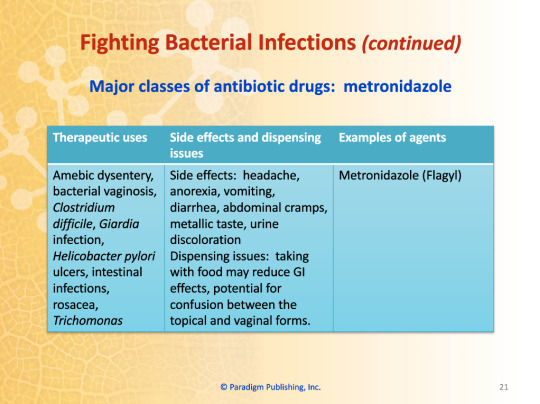
Part One
Part Two
Part Four
Part Five
Transcription under the cut!

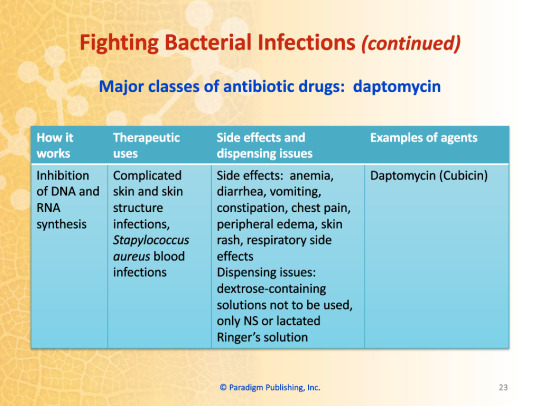
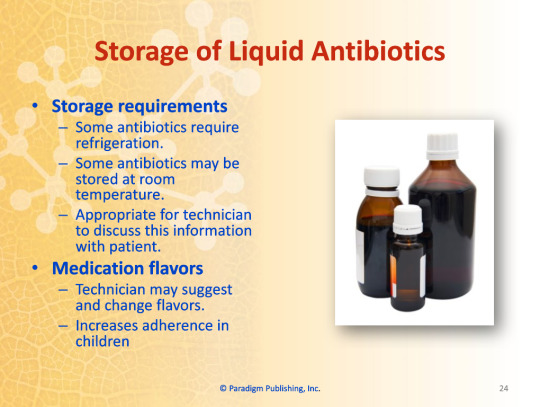
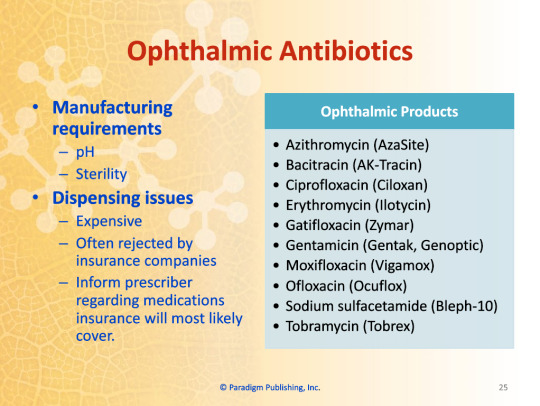
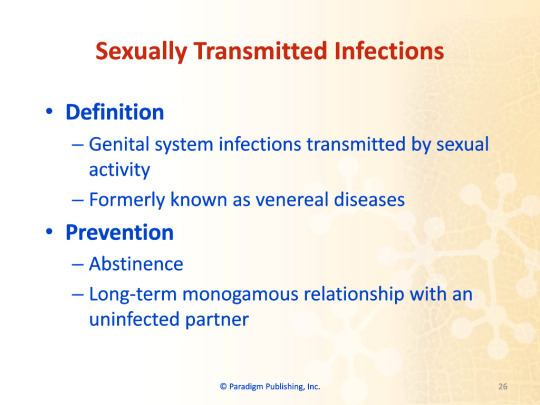
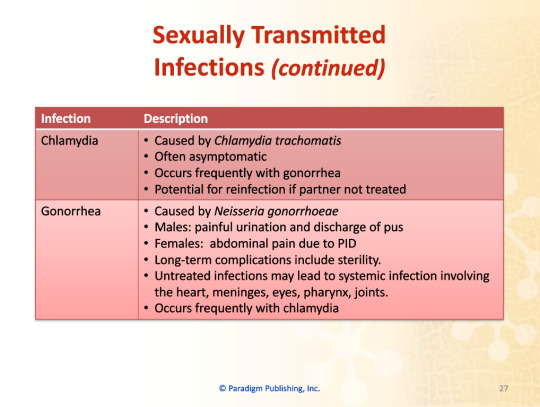
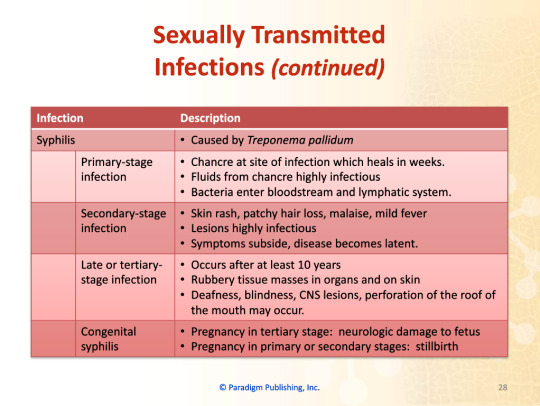
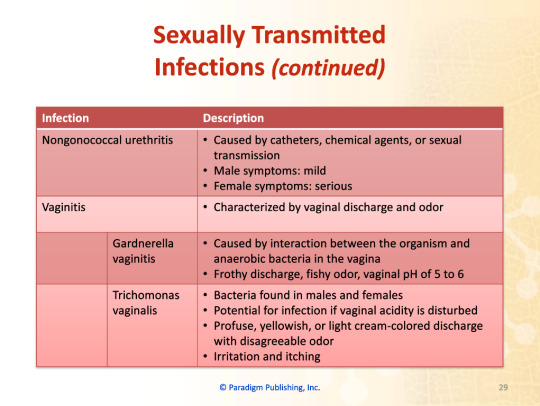
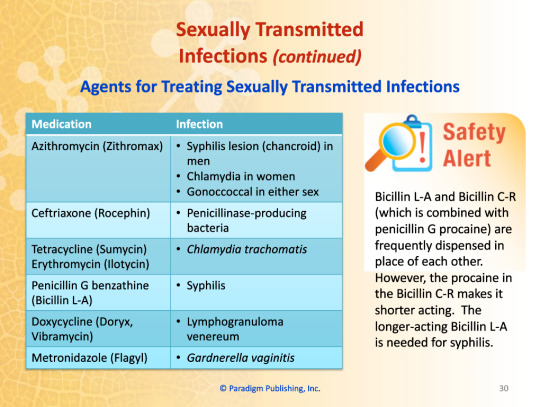
Fighting Bacterial Infections
Major Classes of Antibiotic Drugs: Metronidazole
Therapeutic uses: Amebic dysentery, bacterial vaginosis, Clostridium difficile, Giardia infection, Helicobacter pylori ulcers, intestinal infections, rosacea, Trichomonas
Side effects: headache, anorexia, vomiting, diarrhea, abdominal cramps, metallic taste, urine discoloration
Dispensing issues: taking with food may reduce GI effects, potential for confusion between the topical and vaginal forms
Examples of agents: Metronidazole (Flagyl)
Major Classes of Antibiotic Drugs: Linezolid
How it works: Inhibits bacterial protein synthesis
Therapeutic uses: MRSA, VRE, other Gram positive infections
Side effects: headache, diarrhea, decreased hemoglobin, leukopenia, thrombocytopenia
Dispensing issues: protect from light
Examples of agents: Linezolid (Zyvox)
Major Classes of Antibiotic Drugs: Daptomycin
How it works: Inhibition of DNA and RNA synthesis
Therapeutic uses: Complicated skin and skin structure infections, Staphylococcus aureus blood infections
Side effects: anemia, diarrhea, vomiting, constipation, chest pain, peripheral edema, skin rash, respiratory side effects
Dispensing issues: dextrose-containing solutions not to be used, only NS or lactated Ringer's solution
Examples of agents: Daptomycin (Cubicin)
Storage of Liquid Antibiotics
Storage Requirements
Some antibiotics require refrigeration
Some antibiotics may be stored at room temperature
Appropriate for technicians to discuss this information with patient
Medication flavors
Technician may suggest and change flavors
Increases adherence in children
Ophthalmic Antibiotics
Manufacturing requirements
pH
Sterility
Dispensing issues
Expensive
Often rejected by insurance companies
Inform prescriber regarding medications insurance will most likely cover
Ophthalmic Products
Azithromycin (AzaSite)
Bacitracin (AK-Tracin)
Ciprofloxacin (Ciloxan)
Erythromycin (Ilotycin)
Gatifloxacin (Zymar)
Gentamicin (Gentak, Genoptic)
Moxifloxacin (Vigamox)
Ofloxacin (Ocuflox)
Sodium sulfacetamide (Bleph-10)
Tobramycin (Tobrex)
Sexually-Transmitted Infections
Definition
Genital system infections transmitted by sexual activity
Formerly known as venereal diseases
Prevention
Abstinence
Long-term monogamous relationship with an uninfected partner
Chlamydia
Caused by Chlamydia trachomatis
Often asymptomatic
Occurs frequently with gonorrhea
Potential for reinfection if partner not treated
Gonorrhea
Caused by Neisseria gonorrhoeae
Males: painful urination and discharge of pus
Females: abdominal pain due to PID
Long-term complications include sterility
Untreated infections may lead to systemic infections involving the heart, meninges, eyes, pharynx, joints
Occurs frequently with chlamydia
Syphilis: caused by Treponema pallidum
Primary-stage infection
Chancre at site of infection which heals in weeks
Fluids from chancre highly infectious
Bacteria enter bloodstream and lymphatic system
Secondary-stage infection
Skin rash, patchy hair loss, malaise, mild fever
Lesions highly infectious
Symptoms subside, disease becomes latent
Late- or tertiary-stage infection
Occurs after at least 10 years
Rubbery tissue masses in organs and on skin
Deafness, blindness, CNS lesions, perforation of the roof of the mouth may occur
Congenital syphilis
Pregnancy in tertiary-stage: neurologic damage to fetus
Pregnancy in primary- or secondary-stage: stillbirth
Nongonococcal urethritis
Caused by catheters, chemical agents, or sexual transmission
Male symptoms: mild
Female symptoms: serious
Vaginitis
Characterized by vaginal discharge and odor
Gardnerella vaginitis
Caused by interaction between the organism and anaerobic bacteria in the vagina
Frothy discharge, fishy odor, vaginal pH of 5 to 6
Trichomonas vaginalis
Bacteria found in males and females
Potential for infection if vaginal acidity is disturbed
Profuse, yellowish, or light cream-colored discharge with disagreeable odor
Irritation and itching
Agents for Treating Sexually-Transmitted Infections
Azithromycin (Zithromax)
Syphilis lesions (chancroid) in men
Chlamydia in women
Gonoccoccal in either sex
Ceftriaxone (Rocephin)
Penicillinase-producing bacteria
Tetracycline (Sumycin), Erythromycin (Ilotycin)
Chlamydia trachomatis
Penicillin G benzathine (Bicillin L-A)
Syphilis
Doxycycline (Doryx, Vibramycin)
Lymphogranuloma venereum
Metronidazole (Flagyl)
Gardnerella vaginitis
Safety Alert
Bicillin L-A and Bicillin C-R (which is combined with penicillin G procaine) are frequently dispensed in place of each other. However, the procaine in the Bicillin C-R makes it shorter acting. The longer-acting Bicillin L-A is needed for syphilis.
0 notes
Photo



okay y’all. I think i’m losing my mind here and I need some advice. I’m taking Doryx right now along with aczone in the morning and veltin every other night. Just at work today I got 3 more pimples on my chin 😩 I feel so so defeated. I feel like i’m overreacting, but I also feel like my chin has not improved at all. I was supposed to wait 2 months to go back to the derm and it’s been almost a month and so scheduled another appointment. I think I want to do accutane again. I can’t even think about my face getting as bad as it was before. I am terrified it will get that bad again.
5 notes
·
View notes
Text
Sốt phát ban và những điều cần biết
Sốt phát ban (Typhus) là thuật ng�� chỉ một nhóm các bệnh nhiễm trùng do vi khuẩn hiếm gặp mà mọi người có thể mắc phải sau khi bị côn trùng nhiễm bệnh cắn. Các phân loài khác nhau của vi khuẩn Rickettsia gây ra các loại sốt phát ban khác nhau.
Sốt phát ban là gì?
Sốt phát ban (Typhus) là một căn bệnh gây ra do nhiễm một hoặc nhiều vi khuẩn rickettsia. Bọ chét, ve (chiggers), chấy hoặc ve truyền nó khi chúng cắn bạn. Bọ chét, ve, chấy và ve là những loại động vật không xương sống được gọi là động vật chân đốt.
Khi động vật chân đốt mang vi khuẩn rickettsial cắn ai đó, chúng truyềnvi khuẩn gây bệnh sốt phát ban. Gãi vết cắn tiếp tục mở da và cho phép vi khuẩn tiếp cận với máu nhiều hơn. Khi vào máu, vi khuẩn tiếp tục sinh sản và phát triển.
Có ba loại sốt phát ban khác nhau:
Bệnh dịch (rận sinh)
Sốt phát ban đặc hữu
Sốt phát ban
Loại typhus mà bạn bị nhiễm phụ thuộc vào bit bạn. Động vật chân đốt thường là những người mang một chủng sốt phát ban duy nhất cho loài của họ.
Typhus thường chỉ xảy ra ở các nước đang phát triển hoặc ở các vùng nghèo đói, vệ sinh kém và tiếp xúc gần gũi với con người.
Bệnh Typhus không được điều trị có thể dẫn đến các biến chứng nghiêm trọng và có khả năng gây tử vong. Điều quan trọng là gặp bác sĩ nếu bạn nghi ngờ rằng bạn có thể mắc bệnh sốt phát ban.

Triệu chứng
Các triệu chứng thay đổi một chút theo loại sốt phát ban, nhưng có những triệu chứng liên quan đến cả ba loại sốt phát ban, chẳng hạn như:
Đau đầu
Sốt
Ớn lạnh
Phát ban
Triệu chứng của bệnh typhus thường xuất hiện đột ngột và bao gồm:
Đau đầu dữ dội
Sốt cao (trên 39 ° c)
Phát ban bắt đầu ở lưng hoặc ngực và lan rộng
Lú lẫn
Choáng váng và dường như mất liên lạc với thực tế
Huyết áp thấp (hạ huyết áp)
Nhạy cảm với ánh sáng
Đau cơ nghiêm trọng
Các triệu chứng của bệnh sốt phát ban đặc hữu kéo dài trong 10 – 12 ngày và rất giống với các triệu chứng của bệnh sốt phát ban nhưng thường ít nghiêm trọng hơn. Chúng bao gồm:
Khô ho
Buồn nôn và ói mửa
Bệnh tiêu chảy
Các triệu chứng nhìn thấy ở những người bị bệnh sốt phát ban bao gồm:
Sưng hạch bạch huyết
Mệt mỏi
Tổn thương đỏ hoặc đau trên da tại vị trí vết cắn
Ho
Phát ban
Thời gian ủ bệnh cho bệnh là trung bình năm đến 14 ngày. Điều này có nghĩa là các triệu chứng sẽ không xuất hiện trong tối đa năm đến 14 ngày sau khi bạn bị cắn.
Khách du lịch bị sốt phát ban khi đi du lịch nước ngoài có thể không gặp các triệu chứng cho đến khi họ trở về nhà. Đây là lý do tại sao điều quan trọng là nói với bác sĩ của bạn về bất kỳ chuyến đi gần đây nếu bạn có bất kỳ triệu chứng nào ở trên.
Khi nào đi khám bác sĩ
Nhiễm Typhus rất hiếm, ngay cả trong số những người đi du lịch đến những khu vực phổ biến hơn.
Các triệu chứng giống như cảm lạnh hoặc cúm thường báo hiệu một bệnh do virus. Tuy nhiên, một người gần đây đã đi du lịch hoặc tin rằng họ có nguy cơ mắc bệnh sốt phát ban nên đi khám bác sĩ ngay.
Điều cần thiết là gặp bác sĩ trong các trường hợp sau:
Người gặp phải các triệu chứng là trẻ sơ sinh, người già hoặc người có hệ miễn dịch yếu
Các triệu chứng cảm lạnh hoặc cúm không tự hết
Điều trị bằng kháng sinh cho bệnh typhus không cải thiện triệu chứng trong vài ngày
Triệu chứng mới phát triển sau khi dùng kháng sinh
Nguyên nhân
Typhus là một bệnh nhiễm trùng do vi khuẩn mà một người có thể mắc phải khi tiếp xúc với côn trùng bị nhiễm bệnh.
Côn trùng gây nhiễm trùng bằng cách cắn người hoặc động vật bị nhiễm bệnh. Những con côn trùng lây nhiễm bệnh bằng cách cắn người khác hoặc động vật.
Các côn trùng khác nhau lây lan các loại sốt phát ban khác nhau. Những ví dụ bao gồm:
Chiggers: Chúng mang theo bệnh sốt phát ban, phổ biến nhất ở Đông Nam Á.
Chấy rận trên cơ thể: Một người có thể mắc bệnh sốt phát ban sau khi bị cắn từ rận cơ thể bị nhiễm bệnh.
Bọ chét: Một người có thể mắc bệnh sốt phát ban sau khi tiếp xúc với động vật mang bọ chét bị nhiễm bệnh.
Các yếu tố rủi ro
Một người có nhiều khả năng phát triển bệnh nếu:
Đi du lịch đến một khu vực nơi nhiễm trùng sốt phát ban phổ biến hơn
Ở nơi rất đông đúc, đặc biệt là gần động vật hoặc người vệ sinh kém
Tiếp xúc với bọ chét, từ vật nuôi hoặc từ động vật hoang dã, chẳng hạn như loài gặm nhấm
Họ bị nhiễm chấy
Gần đây đã đi bộ hoặc cắm trại ở những khu vực có bàn chải cao, nơi những kẻ lừa đảo có thể sống
Những người phát triển các triệu chứng của bệnh sốt phát ban và có một hoặc nhiều yếu tố nguy cơ mắc bệnh nên đi khám bác sĩ.
Điều quan trọng là nói với bác sĩ về tất cả các triệu chứng và bất kỳ yếu tố nguy cơ cụ thể nào đối với bệnh sốt phát ban.
Bệnh này bắt chước các triệu chứng của các bệnh do virus khác, chẳng hạn như cảm lạnh và cúm thông thường. Không có thông tin về các yếu tố rủi ro của một người, bác sĩ có thể dễ dàng chẩn đoán sai tình trạng.
Điều trị bệnh sốt phát ban như thế nào?
Thuốc kháng sinh được sử dụng phổ biến nhất để điều trị bệnh sốt phát ban bao gồm:
Doxycycline (Doryx, Vibramycin): phương pháp điều trị ưu tiên
Chloramphenicol: một lựa chọn cho những người không mang thai hoặc cho con bú
Ciprofloxacin (Cipro): được sử dụng cho người lớn không thể dùng doxycycline

Phòng ngừa
Hiện tại không có vắc-xin để ngăn ngừa bệnh typhus, và không có cách nào khác để đảm bảo phòng ngừa. Tuy nhiên, các bước sau đây có thể làm giảm nguy cơ mắc bệnh, đặc biệt là khi đi du lịch:
Không mặc quần áo chung: Mọi người nên tránh mặc chung quần áo của nhau. Điều này đặc biệt quan trọng khi sống trong khu vực gần, hoặc khi tiếp xúc với côn trùng mang bệnh.
Vệ sinh quần áo: Một người nên giặt bất kỳ quần áo nào đã tiếp xúc với chấy, bọ chét hoặc chiggers. Ngoài ra, mọi người có thể niêm phong quần áo trong một túi nhựa trong ít nhất 2 tuần.
Mặc quần áo phù hợp: Mặc áo tay dài và vớ khi đi cắm trại có thể giúp ngăn ngừa vết cắn của người kích hoạt.
Tránh khu vực đông nhười: Mọi người nên tránh các khu vực đông nười, có nhiều khả năng lưu trữ các chiggers.
The post Sốt phát ban và những điều cần biết appeared first on CaNets.
from CaNets Canets là trang tin tức tổng hợp về sức khỏe, sắc đẹp, ẩm thực…với mục đích chia sẻ những kiến thức bổ ích cho đọc giả mang lại những kiến thức hỗ trợ sức khỏe và sức khỏe tốt đó là những gì Canets hướng đến. website: https://canets.com/ SĐT: 0933249921 Địa chỉ: 81 Cách Mạng Tháng Tám, Phường Phạm Ngũ Lão, Quận 1, Thành Phố Hồ Chí Minh
0 notes
Text
The Amebiasis Treatment Can Offer Opportunities for Payers as Consumer Demand for Cost-Effective Pharmaceuticals Rises

Amebiasis is an infection of the intestine caused by a parasite Entamoeba Histolytica. Symptoms of this disease include loose stool, abdominal cramping, and stomach pain. Amebiasis is common in regions with low developed sanitation facilities such as Asia Pacific, Central America, South America, and some parts of Africa. Amebiasis is mainly transmitted through water or food contaminated with Entamoeba Histolytica. Amebiasis can lead to diarrhea (with or without blood) in both adults and children, leading to high morbidity and mortality. The organism, Entamoeba Histolytica, can damage organ and may require surgical intervention, if the colon and other tissues have undergone perforation. However, amebiasis can be treated with some antibiotic, anti- parasitic, and antiprotozoal drugs such as metronidazole, paromomycin, and tinidazole. Diagnosis of this disease is usually made by microscopic identification of the microorganism in a stool specimen.
Get Exclusive Sample Report at: https://www.coherentmarketinsights.com/insight/request-sample/1595
Amebiasis Treatment Market Drivers
Increasing approvals and launches of new drugs indicated for the treatment of amebiasis is expected to be a major factor for growth of amebiasis treatment market. For instance, in 2017, Dr. Reddy's Laboratories received U.S. Food and Drug Administration (FDA) approval for its Minolira (minocycline) extended-release tablets, indicated for the treatment of a variety of bacterial infections and as adjunctive therapy in acute intestinal amebiasis. Moreover, in 2016, Rising Pharmaceuticals, Inc.—a subsidiary of Aceto Corporation—launched Metronidazole Tablets, 250mg and 500mg, generic version of Flagyl manufactured by G.D. Searle, LLC’s, indicated for the treatment of amebiasis and a variety of anaerobic bacterial infections. In 2016, Mylan Pharmaceuticals Inc. received ANDA approval for its Doryx (Doxycycline Hyclate) Delayed-Release Tablets, 50 mg, indicated for the treatment of acute intestinal amebiasis. Furthermore, increasing prevalence of amebiasis in region with poor sanitation facilities such as Africa and some countries in Asia Pacific is expected to lead to increasing demand for its treatment, which in turn is expected to drive growth of the amebiasis treatment market in the near future. For instance, according to data published by International Research Journal of Biological Sciences, in 2013, the prevalence of amebiasis among school children in Lafia, Nigeria was around 26.7%. The highest prevalence of amebiasis was 40.0% in children of Government Secondary School Tudun Kauri, Lafia. This high prevalence of amebiasis was due to poor environmental/drainage system, unhygienic methods of disposing sewage, and shortage of clean water supply.
Amebiasis Treatment Market Regional Analysis
Africa is expected to show a significant growth in the global amebiasis treatment market over the forecast period, owing to high prevalence rate of amebiasis due to poor sanitation and low availability of clean drinking water. For instance, according to data published by United Nations Department of Economic and Social Affairs (UNDESA), in 2014, around 115 people in Africa die every hour from diseases linked to poor sanitation, poor hygiene, and contaminated water. In Sub-Saharan Africa around 40% of the 783 million people do not have access to a clean source of drinking water. Furthermore, Asia Pacific region is expected to show significant growth in amebiasis treatment market over the forecast period, owing to increasing prevalence of amebiasis in some rural areas of India and China. For instance, according to data published on National Health Portal of India, in 2015, amebiasis affected about 15% of the total population in India.
Amebiasis Treatment Market Restraint
Amebiasis is an infectious disease, which is native to areas with poor sanitation facilities and lack of clean drinking water supply. The people living in rural areas have low access to drugs, due to low presence of hospitals and healthcare professionals. The absence of good healthcare facilities and low access to drugs is expected to be major factor restraining growth of the amebiasis treatment market.
Amebiasis Treatment Market Key Players
Key players operating in amebiasis treatment market include Pfizer Inc., Impax Laboratories, Lupin Pharmaceuticals, Inc., Sanofi, Actelion Pharmaceuticals Ltd., Glenmark Pharmaceuticals, Sun Pharmaceutical Industries Inc., Heritage Pharmaceuticals Inc., Mission Pharmacal Co., Novel Laboratories, and others. Key players in the market are focusing on launching generic versions of branded medicines indicated for treatment of amebiasis. For instance, in 2017, Mayne Pharma Group Limited received FDA approval for its Doxycyline Hyclate IR Tablets, first generic to Acticlate. Doxycycline Hyclate 75 mg and 150 mg are tetracycline class drugs indicated for adjunctive therapy for acute intestinal amebiasis.
Inquire Here Before Purchase of Research Report @ https://www.coherentmarketinsights.com/insight/talk-to-analyst/1595
Amebiasis Treatment Market Taxonomy:
The global amebiasis treatment market is segmented on the basis of drug type, distribution channel, and region:
By Drug Type-
Metronidazole
Paromomycin
Tinidazole
Iodoquinol
Dehydroemetine
Chloroquine phosphate
Others
By Distribution Channel-
Hospitals
Online Pharmacies
Retail Pharmacies
By Region
North America
Latin America
Europe
Asia Pacific
Middle East
Africa
About Coherent Market Insights
Coherent Market Insights is a prominent market research and consulting firm offering action-ready syndicated research reports, custom market analysis, consulting services, and competitive analysis through various recommendations related to emerging market trends, technologies, and potential absolute dollar opportunity.
Contact Us
Mr. Shah
Coherent Market Insights
1001 4th Ave, #3200
Seattle, WA 98154
Tel: +1-206-701-6702
Email: [email protected]
0 notes
Text
Amebiasis Treatment Market Industry Size, Share, Outlook, and Forecast 2018-2026
Amebiasis can lead to diarrhea (with or without blood) in both adults and children, leading to high morbidity and mortality. The organism, Entamoeba Histolytica, can damage organ and may require surgical intervention, if the colon and other tissues have undergone perforation. However, amebiasis can be treated with some antibiotic, anti- parasitic, and antiprotozoal drugs such as metronidazole, paromomycin, and tinidazole. Diagnosis of this disease is usually made by microscopic identification of the microorganism in a stool specimen.
Increasing approvals and launches of new drugs indicated for the treatment of amebiasis is expected to be a major factor for growth of amebiasis treatment market. For instance, in 2017, Dr. Reddy's Laboratories received U.S. Food and Drug Administration (FDA) approval for its Minolira (minocycline) extended-release tablets, indicated for the treatment of a variety of bacterial infections and as adjunctive therapy in acute intestinal amebiasis.
Request Sample Report@ https://www.coherentmarketinsights.com/insight/request-sample/1595
Moreover, in 2016, Rising Pharmaceuticals, Inc.—a subsidiary of Aceto Corporation—launched Metronidazole Tablets, 250mg and 500mg, generic version of Flagyl manufactured by G.D. Searle, LLC’s, indicated for the treatment of amebiasis and a variety of anaerobic bacterial infections. In 2016, Mylan Pharmaceuticals Inc. received ANDA approval for its Doryx (Doxycycline Hyclate) Delayed-Release Tablets, 50 mg, indicated for the treatment of acute intestinal amebiasis. Furthermore, increasing prevalence of amebiasis in region with poor sanitation facilities such as Africa and some countries in Asia Pacific is expected to lead to increasing demand for its treatment, which in turn is expected to drive growth of the amebiasis treatment market in the near future.
For instance, according to data published by International Research Journal of Biological Sciences, in 2013, the prevalence of amebiasis among school children in Lafia, Nigeria was around 26.7%. The highest prevalence of amebiasis was 40.0% in children of Government Secondary School Tudun Kauri, Lafia. This high prevalence of amebiasis was due to poor environmental/drainage system, unhygienic methods of disposing sewage, and shortage of clean water supply.
Click to view the full report TOC, figure and tables: https://www.coherentmarketinsights.com/ongoing-insight/toc/1595
Africa is expected to show a significant growth in the global amebiasis treatment market over the forecast period, owing to high prevalence rate of amebiasis due to poor sanitation and low availability of clean drinking water. For instance, according to data published by United Nations Department of Economic and Social Affairs (UNDESA), in 2014, around 115 people in Africa die every hour from diseases linked to poor sanitation, poor hygiene, and contaminated water.
In Sub-Saharan Africa around 40% of the 783 million people do not have access to a clean source of drinking water. Furthermore, Asia Pacific region is expected to show significant growth in amebiasis treatment market over the forecast period, owing to increasing prevalence of amebiasis in some rural areas of India and China. For instance, according to data published on National Health Portal of India, in 2015, amebiasis affected about 15% of the total population in India.
Key players operating in amebiasis treatment market include Pfizer Inc., Impax Laboratories, Lupin Pharmaceuticals, Inc., Sanofi, Actelion Pharmaceuticals Ltd., Glenmark Pharmaceuticals, Sun Pharmaceutical Industries Inc., Heritage Pharmaceuticals Inc., Mission Pharmacal Co., Novel Laboratories, and others. Key players in the market are focusing on launching generic versions of branded medicines indicated for treatment of amebiasis. For instance, in 2017, Mayne Pharma Group Limited received FDA approval for its Doxycyline Hyclate IR Tablets, first generic to Acticlate. Doxycycline Hyclate 75 mg and 150 mg are tetracycline class drugs indicated for adjunctive therapy for acute intestinal amebiasis.
For More Information On This Report, Please Visit @ https://www.coherentmarketinsights.com/ongoing-insight/amebiasis-treatment-market-1595
0 notes
Text
Amebiasis Treatment Market Research Trends Report 2026
To Gain More Insights into the Amebiasis Treatment Market, Browse Summary of the Research Report –
Amebiasis is an infection of the intestine caused by a parasite Entamoeba Histolytica. Symptoms of this disease include loose stool, abdominal cramping, and stomach pain. Amebiasis is common in regions with low developed sanitation facilities such as Asia Pacific, Central America, South America, and some parts of Africa. Amebiasis is mainly transmitted through water or food contaminated with Entamoeba Histolytica. Amebiasis can lead to diarrhea (with or without blood) in both adults and children, leading to high morbidity and mortality. The organism, Entamoeba Histolytica, can damage organ and may require surgical intervention, if the colon and other tissues have undergone perforation. However, amebiasis can be treated with some antibiotic, anti- parasitic, and antiprotozoal drugs such as metronidazole, paromomycin, and tinidazole. Diagnosis of this disease is usually made by microscopic identification of the microorganism in a stool specimen.
https://www.coherentmarketinsights.com/ongoing-insight/amebiasis-treatment-market-1595
Increasing approvals and launches of new drugs indicated for the treatment of amebiasis is expected to be a major factor for growth of amebiasis treatment market. For instance, in 2017, Dr. Reddy's Laboratories received U.S. Food and Drug Administration (FDA) approval for its Minolira (minocycline) extended-release tablets, indicated for the treatment of a variety of bacterial infections and as adjunctive therapy in acute intestinal amebiasis. Moreover, in 2016, Rising Pharmaceuticals, Inc.—a subsidiary of Aceto Corporation—launched Metronidazole Tablets, 250mg and 500mg, generic version of Flagyl manufactured by G.D. Searle, LLC’s, indicated for the treatment of amebiasis and a variety of anaerobic bacterial infections. In 2016, Mylan Pharmaceuticals Inc. received ANDA approval for its Doryx (Doxycycline Hyclate) Delayed-Release Tablets, 50 mg, indicated for the treatment of acute intestinal amebiasis. Furthermore, increasing prevalence of amebiasis in region with poor sanitation facilities such as Africa and some countries in Asia Pacific is expected to lead to increasing demand for its treatment, which in turn is expected to drive growth of the amebiasis treatment market in the near future.
For instance, according to data published by International Research Journal of Biological Sciences, in 2013, the prevalence of amebiasis among school children in Lafia, Nigeria was around 26.7%. The highest prevalence of amebiasis was 40.0% in children of Government Secondary School Tudun Kauri, Lafia. This high prevalence of amebiasis was due to poor environmental/drainage system, unhygienic methods of disposing sewage, and shortage of clean water supply.
“We Do Offer Sample of Amebiasis Treatment Market Report. Kindly go through the follow information in order to access sample copy.”
https://www.coherentmarketinsights.com/insight/request-sample/1595
Africa is expected to show a significant growth in the global amebiasis treatment market over the forecast period, owing to high prevalence rate of amebiasis due to poor sanitation and low availability of clean drinking water. For instance, according to data published by United Nations Department of Economic and Social Affairs (UNDESA), in 2014, around 115 people in Africa die every hour from diseases linked to poor sanitation, poor hygiene, and contaminated water. In Sub-Saharan Africa around 40% of the 783 million people do not have access to a clean source of drinking water. Furthermore, Asia Pacific region is expected to show significant growth in amebiasis treatment market over the forecast period, owing to increasing prevalence of amebiasis in some rural areas of India and China. For instance, according to data published on National Health Portal of India, in 2015, amebiasis affected about 15% of the total population in India.
Table of Contents
https://www.coherentmarketinsights.com/ongoing-insight/toc/1595
Top players in the market
Key players operating in amebiasis treatment market include Pfizer Inc., Impax Laboratories, Lupin Pharmaceuticals, Inc., Sanofi, Actelion Pharmaceuticals Ltd., Glenmark Pharmaceuticals, Sun Pharmaceutical Industries Inc., Heritage Pharmaceuticals Inc., Mission Pharmacal Co., Novel Laboratories, and others. Key players in the market are focusing on launching generic versions of branded medicines indicated for treatment of amebiasis. For instance, in 2017, Mayne Pharma Group Limited received FDA approval for its Doxycyline Hyclate IR Tablets, first generic to Acticlate. Doxycycline Hyclate 75 mg and 150 mg are tetracycline class drugs indicated for adjunctive therapy for acute intestinal amebiasis.
Research methodology adopted by Coherent Market Insights
Coherent Market Insights followsa comprehensive research methodology focused on providing the most precise market analysis. The company leverages a data triangulation model which helps company to gauge the market dynamics and provide accurate estimates. Key components of the research methodologies followed for all our market reports include:
Primary Research (Trade Surveys and Experts Interviews)
Desk Research
Proprietor Data Analytics Model
In addition to this, Coherent Market Insights has access to a wide range of the regional and global reputed paid data bases, which helps the company to figure out the regional and global market trends and dynamics. The company analyses the industry from the 360 Degree Perspective i.e. from the Supply Side and Demand Side which enables us to provide granular details of the entire ecosystem for each study. Finally, a Top-Down approach and Bottom-Up approach is followed to arrive at ultimate research findings.
Request A Sample Copy Amebiasis Treatment Market Report Click here:
https://www.coherentmarketinsights.com/insight/request-sample/1595
Get PDF Research Report Brochure @
https://www.coherentmarketinsights.com/insight/request-pdf/1595
Buy Now this Premium Report to Grow your Business @
https://www.coherentmarketinsights.com/insight/buy-now/1595
About Us:
Coherent Market Insights is a global market intelligence and consulting organization focused on assisting our plethora of clients achieve transformational growth by helping them make critical business decisions.
Contact Us:
Name: Mr. Raj Shah
Email: [email protected]
Phone: US +12067016702
Country: United States
Visit our Blog: https://hospitalhealthcareblog.wordpress.com/
0 notes
Text



The GrinchOkami tradition continues, with extras for my partner and friend~
#furry#furry art#digital art#anthro#my ocs#art for others#my art#okamiwhitewings#whitewingsart#2024#Doryx#Skye Whitewings#Ari#Hades' Cave#grinchokami
12 notes
·
View notes
Link
Rainbow Six Siege Void Edge dévoile la refonte d'Oryx, Iana et Oregon - TheSixthAxis
0 notes
Photo

hey all my accutane peeps! so here is the current skin situation...My skin was as clear as can be with some extremely minor little pimples from time to time (very normal, went away within 2 days) BUT the last month or so my chin had a freak out. it was nothing too major but it scared me enough to go back to the derm bc the acne was slowly starting to accumulate. i had little pimples and milia all over my chin, but i haven’t had any cystic acne since completing accutane. so the derm put me on doryx (antibiotic) for the next month, aczone every morning, and veltin every other night. it’s been almost a week and my chin has seemed to calm down a little bit. my fingers are crossed...she said that if this does nothing I will be doing accutane for a second course :( disappointing, but doable. wish me luck!!!
2 notes
·
View notes
Text
Visiongain Report Provides Critical Market-led Data on the $36bn Dermatological Drugs Market
LONDON, June 6, 2019 /PRNewswire/ — Dermatological drugs market has been growing over the last decade. A combination of significant new market launches, and corporate activities has changed the outlook of the pharmaceutical industry towards this market. The dermatological drugs market in 2018 was reported to be US$ 26.23bn. Visiongain’s analysis of the market shows Humira, Stelara, Enbrel, Remicade, Otezla and Cosentyx among the top dermatological drugs driving the market at present.
How this report will benefit you Read on to discover how you can exploit the future business opportunities emerging in this sector.
In this brand new 176-page report you will receive 108 tables and 71 figures– all unavailable elsewhere.
The 176-page Visiongain report provides clear detailed insight into the top 25 dermatological drugs manufacturers. Discover the key drivers and challenges affecting the market.
To request sample pages from this report please contact Sara Peerun at [email protected] or refer to our website: https://www.visiongain.com/report/top-25-dermatological-drugs-manufacturers-2019/#download_sampe_div
Report Scope
• Assessment of the leading companies in the global dermatological drugs market. The list below shows some of the companies that are discussed in the report: • Abbvie Inc. • Allergan plc • Almirall S.A. • Amgen • Astellas • Bayer • Concert Pharmaceuticals • Eli Lilly and Company • Galderma • GlaxoSmithkline plc (GSK) • Johnson & Johnson (J&J) • Leo Pharma A/S • Lupin Ltd • Mayne Pharma • Other companies
• For each company, the report provides information and discussion on: • Total revenue forecast to 2028 • Dermatology segment revenue forecast to 2028 • The leading dermatology drugs revenue forecast to 2028 • Drugs portfolio • Recent developments
• The report provides revenue forecast to 2028 for the following dermatological drugs: • Epiduo • Differin • Stelara • Remicade • Humira • Valtrex • Lamisil • Bactroban • Dermovate • Zyvox • Protopic • Solodyn • Ziana • Taltz • Cosentyx • Aczone • Cubicin • Elocon • Absorica /Epirus • Enbrel • Doryx • Canesten • Bepanthen/Bepanthol
• Key questions answered by this report: • How is the Dermatological Drugs Manufacturers market evolving? • What is driving and restraining the Dermatological Drugs Manufacturers market? • What will be the main driver for the overall market to 2028? • Will leading Dermatological Drugs Manufacturers broadly follow the macroeconomic dynamics, or will individual national markets outperform others? • Who are the leading players and what are their prospects over the forecast period?
To request a report overview of this report please contact Sara Peerun at [email protected] or refer to our website: https://www.visiongain.com/report/top-25-dermatological-drugs-manufacturers-2019/
Did you know that we also offer a report add-on service? Email [email protected] to discuss any customized research needs you may have.
Companies covered in the report include:
23andMe, Inc. Abbott Laboratories AbbVie Inc. Ablynx NV Actavis plc Advent International Allergan plc Almirall S.A. American Academy of Dermatology (AAD) Amgen ARMO BioSciences Astellas Pharma Inc. Avanir Pharmaceuticals, Inc. Bausch Health Companies Inc. Bayer AG Calico Life Sciences LLC Celgene Corporation Celgene International Sarl Celgene Pharmaceuticals, Inc. Concert Pharmaceuticals, Inc. Dermavant Sciences Eli Lilly and Company European Commission (EC) European Medicines Agency (EMA) FibroTx LLC Food and Drug Administration (FDA) Galapagos Galderma GlaxoSmithkline plc (GSK) Hill Dermaceuticals, Inc. Igenica Biotherapeutics Janssen Jazz Pharmaceuticals, Inc. Johnson & Johnson (J&J) KNOW Bio L’Oréal Laboratorios Almirall, S.A. Leo Pharma A/S Lupin Ltd Mayne Pharma Group Limited Meda Aktiebolag Merck Mitsubishi Tanabe Pharma MorphoSys Mylan N.V. Nestlé Nestle Skin Health S.A. New Moon B.V. Novan, Inc. Novartis AG Pfizer Inc. Pharmaceuticals and Medical Devices Agency (PMDA)Pierre Fabre S.A. Proteostasis Therapeutics, Inc. Renaissance Acquisition Holdings, LLC. Revance Therapeutics, Inc. Rigontec Roche Roivant Sciences Samsung BioLogics Sandoz SangStat Sanofi Stiefel Laboratories Sun Pharmaceutical Industries, Ltd. Taro Pharmaceuticals U.S.A Inc. The University of Texas MD Anderson Cancer Center Universal Cells, Inc. Valeant Pharmaceuticals Viralytics Limited
To see a report overview please e-mail Sara Peerun on [email protected]
Related reports:
Dermatological Drugs Market Forecast 2018-2028
Pharma Leader Series: Top 50 Pharmaceutical Contract Manufacturing Organisations (CMOs) Market 2018
Pharmaceutical Contract Manufacturing Market 2018-2028
Global Medical Device Contract Manufacturing Market Forecast 2018-2028
Drug Delivery Technologies Market Forecast 2019-2029
Biologics Market Trends and Forecasts 2018-2028
SOURCE Visiongain
The post Visiongain Report Provides Critical Market-led Data on the $36bn Dermatological Drugs Market appeared first on The Chestnut Post.
from The Chestnut Post https://www.thechestnutpost.com/news/visiongain-report-provides-critical-market-led-data-on-the-36bn-dermatological-drugs-market/
0 notes